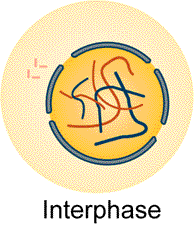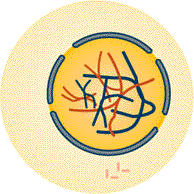
Review behavioral objective 8. The answer to the question on the preceding page is included in the readings indicated by G-5. Cells spend most of their time in the interphase stage. The time cells spend here may vary from five hours to many years. Most of the cells in your body cells (somatic) are in the interphase stage. More specifically they are in the G-1 stage. Just before mitosis the DNA content doubles. This occurs during the S stage of .mitosis. The reason for this that at the end of mitosis two daughter cells will form with the same amount of DNA in each cell as the single mother cell; therefore, a doubling of DNA must occur before the chromosomes form and segregate into two cells. Examine the two figures below. The top figure represents a cell during the G-1 stage and the bottom figure represents a figure during the G-2 stage after DNA synthesis (S stage). Note the doubling of DNA in the bottom figure. Draw and explain these figures in your notes.
k- G-1 stage 
S stage DNA replication
k- G-2 stage 
Note: The DNA in the G - 2 stage has not only doubled but
the two strands are connected.
9. Study the figure above. How many DNA molecules are their in the G-1 and G-2 figure respectfully?
a. 12 : 24
c. 6 : 12
b. 24 : 48
d . 24 : 24
Press here to check answer. press
10. Most of the epithelial cells that make up your skin are in which
stage of the cell cycle?
a. S
c. G2
b.Mitotic
d. G1
Press here to check answer. press
11. How many DNA molecules and chromosomes are present
in the human somatic (body) cell during the "G1" and "G2" stage
of interphase? (human somatic cells are the normal diploid cells that make
up the human body)
G1 G2 G1 G2
a. 23 : 46 46 : 92 c. 46 : 46 46 : 46
b. 46 : 23
46 : 23
d. 46 : 46
92 : 46
Press here to check answer. press
Examine the figures above showing interphase (G-1) and interphase (G-2) after DNA synthesis. . In your notes draw these figures showing the three pairs of chromosomes.
Now add genes to these chromosome pairs. Use the letters "A and B" to represent the genes. Add to the long red and blue homologous pair the genes "A" and "B". Indicate one of the homologous pair "A" genes with an upper case A and it's homologue with a lower case a. Indicate one of the homologous pair "B" genes with an upper case B and it's homologue with a lower case b. Compare your answer to the figures below. Your will be asked to follow this assignment through the mitotic stages of cell division during a later lessons..
Check your figure to the one shown below. Click here. click
G-1 G-2
G-2
The letters represent genes on the DNA molecules. Note the position
of the genes in the G-2 figure. The mother DNA with its genes synthesized
a daughter strand with the same genes and remained attached to the mother
DNA. This concept is very important for you to understand mitosis and meiosis.
Draw these figures in your notes along with the letters designating the
genes. To check the correct observation you must answer the following question
correctly to move to the next page.
Which of the following show the correct representation of the genes on its designated DNA molecule in the G-2 stage? The correct answer will move you to the next page.
a ) aaBB and AAbb
b ) aabb and AABB
c ) AaBb and AaBb
For information on how to use this page, go to How
to Use This Site.
Created by the Center for Learning Technologies, Academic Technology Services.
Last modified October 22, 1997.